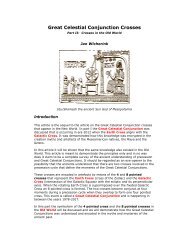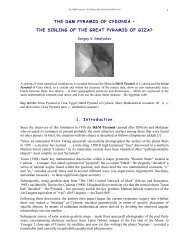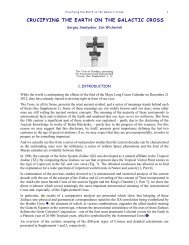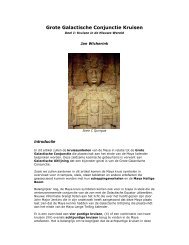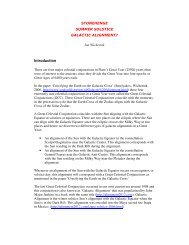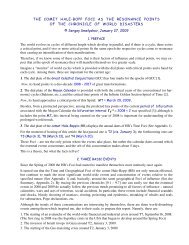Appendix MARS AND D&M PYRAMID ... - Souls of Distortion
Appendix MARS AND D&M PYRAMID ... - Souls of Distortion
Appendix MARS AND D&M PYRAMID ... - Souls of Distortion
Create successful ePaper yourself
Turn your PDF publications into a flip-book with our unique Google optimized e-Paper software.
<strong>Appendix</strong> to “The D&M Pyramid – the Sibling <strong>of</strong> the Great Pyramid <strong>of</strong> Giza?” 2<br />
A3. Mars radii and intrinsic units <strong>of</strong> measure<br />
The basic linear measures <strong>of</strong> Mars are as follows [6]<br />
Equatorial radius<br />
Polar radius<br />
R E = 3402.5 km;<br />
R = 3377.4 km.<br />
P<br />
Comment A2. Find the intrinsic units <strong>of</strong> linear measure for Mars by analogy with the geographical mile.<br />
A3.1. The lengths <strong>of</strong> 1° and 1’ <strong>of</strong> Equator<br />
2πRE<br />
Λ E = = 59.38483 (km /degree);<br />
360°<br />
ΛE λ E = 10 3<br />
60 × = 989.7471 (m/arc min).<br />
A3.2. Find the length <strong>of</strong> 1° <strong>of</strong> the latitudinal circle for the latitude <strong>of</strong> the D&M.<br />
Consider a cross-section <strong>of</strong> Mars as ellipse with semi-axes a = R and b = R (Fig. A1).<br />
R P<br />
ψr<br />
R ψ<br />
E<br />
P<br />
ψ<br />
R E<br />
Fig. A1. Radius r ψ <strong>of</strong> the latitudinal circle for the D&M pyramid<br />
2<br />
2<br />
2<br />
2<br />
The radius-vector R ψ for D&M makes Rψ<br />
= ( RE<br />
cosψ<br />
) + ( RP<br />
sinψ<br />
) = 3391 .871 , where ψ = 40.65°<br />
is its latitude (See A4). Then, the radius r ψ <strong>of</strong> its latitudinal circle is equal to r ψ = R ψ cos ( ψ )<br />
= 3391.871× cos 40. 65 = 2573.423 (km) and the lengths <strong>of</strong> 1° and 1’ <strong>of</strong> D&M latitudinal circle make<br />
2πr<br />
ψ<br />
Λ D = = 44.9147 (km /degree);<br />
360°<br />
Λ<br />
λ D =<br />
D 10 3<br />
60 × = 748.578 (m/arc min).<br />
A3.3. Find the average length <strong>of</strong> 1° <strong>of</strong> meridian.<br />
The following approximation gives the length <strong>of</strong> ellipse with half-axes a and b<br />
64 − 3λ<br />
a − b<br />
L ≈ π(<br />
a + b ) , λ = .<br />
2<br />
64 − 16λ<br />
a + b<br />
64 − 3λ<br />
Hence, for Mars we obtain λ = 0. 003702 , L ≈ π( 3402.5 + 3377.4 ) = 21 299. 757 (km), and<br />
2<br />
64 − 16λ<br />
the average length <strong>of</strong> 1° and 1’ <strong>of</strong> Meridian make<br />
ΛM<br />
L<br />
= 360°<br />
Λ<br />
M<br />
λM = × 10<br />
60<br />
4<br />
= 59.16599 (km/degree);<br />
3<br />
= 986 (m/arc min).<br />
4





